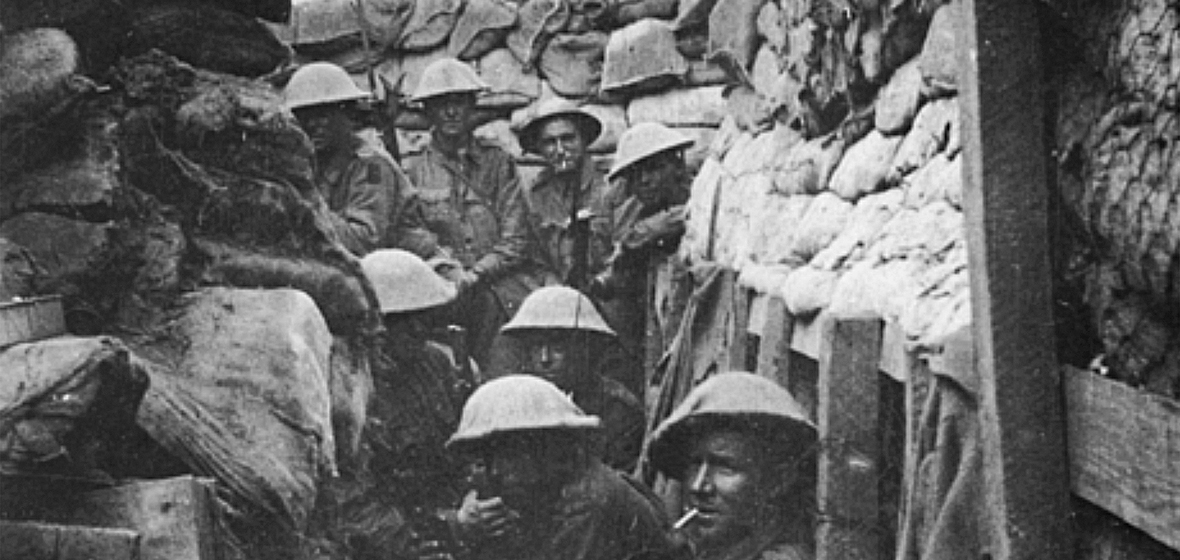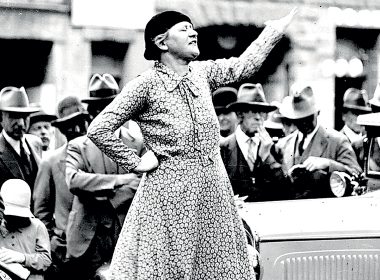A long way from the civilised world of the Sydney law precinct. Men of the 53rd Battalion, led by barrister Lieut Col Ignatius Bertram Norris and containing a number of lawyers, ready in the hours leading up to the Battle of Fromelles. Only three men from this photo survived, and they were wounded.
Law Society of NSW unveiled an honour board commemorating solicitors, articled clerks and law students killed in action in World War I. The events surrounding the Battle of the Somme were a turning point: war would become an interminable horror that split society, led to grief on a mass scale and left a lasting mark on the NSW legal profession.
By the end of 1915, at least 150 solicitors, law clerks and students had enlisted for service overseas. Ten had been killed in action before the troops withdrew from Gallipoli to reorganise in Egypt in early 1916 for the next phase of the war.
Solicitor John Maughan was one of many thousands who made the hazardous voyage from Egypt to Marseilles in France, then travelled by train north to assemble for battle on the Western Front. He described the journey as being “really very pretty, (with) fruit trees especially just in blossom” and recalled how the Australian boys delighted in the “the fine old churches and cathedrals” with “just a glimpse of the Eiffel Tower and of Versailles”.
Lawyers were rising up the ranks. Newly promoted solicitor Major Bertie Vanderleur Stacy replaced thoroughly worn-out fellow Sydney solicitor Lieutenant Colonel Charles Macnaghten as officer commanding the Fourth Battalion. Macnaghten never recovered, mentally or physically, from his experiences at Gallipoli. Another solicitor, Captain Adam James Simpson, the son of Justice Simpson, was also proving himself a fine leader of men – working with a “fiery energy” to prepare his men for battle – despite the fact he had been wounded, and his brother George had been killed at Gallipoli. The men needed to train hard because the next phase of the war entailed trench warfare against the Germans in France and Belgium.
Solicitor Lieutenant Robert Clive Hunter, from Forbes, was a classmate of Adam Simpson from the Sydney University Law School. Hunter had survived Gallipoli then he, too, made the journey to France via Marseilles. On 12 April he marched to billets in the town of Fleurbaix, described in his unit history as “a mud-encompassed hell”. The soldiers could see the towns of Fromelles and Lille from their observation post. Hunter’s unit left the line on 3 May. He went on leave to London then rejoined his unit on 10 June. Three days later he was dead, shot in the head as he looked over the parapet at the raids and bombardments that took place in the violent space between the Australian and the German lines. Violent as they were, the various trench raids and bombardments at Fleurbaix were a sideshow to the great battle of the Somme, which started on 1 July just a few miles to the south.
The battle of the Somme was known as the “Big Push” to end the war and became one of the iconic tragedies of the conflict. Sydney law student Adrian Consett Stephen was the son of Alfred Stephen, the founder of the law firm Stephen Jaques and Stephen. Adrian was a talented writer and destined for a career in the law. He was serving with the Royal Field Artillery at the battle overlooking the valley of the Somme. He wrote of the woods “seething with traffic: ammunition, wagons, guns, transports, and marching men. A deep low growl filled the air. Night roared with the lumbering of endless wheels”. It was war on an industrial scale.
On the first day of the battle, there were 60,000 British and Canadian casualties. The Somme offensive rapidly faltered and the deadly process of wearing down the enemy in “attrition warfare” began. One of the major features of the first day of battle was the massive artillery barrage. Consett Stephen described the experience: “The world burst into a gigantic roar that was flung from horizon to horizon as thunder is tossed about mountains. The bark of the 18 pounders, the cough of the howitzers, the boom of the heavy guns, and the lightning rush of naval guns, swelled and merged into a jerky rumble … It throbbed exultantly with a sense of infinite power.”

In an attempt to induce the Germans to move some troops away from the main action around the Somme River Valley, the British High Command conceived a diversionary attack starting at Fleurbaix to the north, targeting the Germans who were entrenched to the east in what had once been a pretty French village named Fromelles. The attack was planned for the night of 19-20 July.
The guns call to me from a distance; they fascinate and repel, but there is a fascination, though it might be unpleasant, like the fascination of a snake.
Written by law student Adrian Consett Stephen after the battle of Pozieres in 1916 to his father, solicitor Alfred Stephen, founder of the law firm Stephen Jaques and Stephen (now King & Wood Mallesons).
Many families would grieve over the name of Fromelles. It was a much criticised disaster. Everything went wrong. The Germans knew the Australians were coming. Men got lost in the darkness. The German trenches, which were supposed to be captured to give the men shelter, proved to be simply mud-filled irrigation ditches, while the Germans themselves were safely hidden in strong defences beyond the mess. The Germans counter-attacked with ferocity and, at dawn, hundreds of Australians straggled back to their lines across open ground. A number of solicitors were among the casualties from that terrible night.
The 53rd Battalion had gone into action on 20 July at Fromelles under the command of well-known Sydney barrister Lieutenant Colonel Ignatius Bertram (Bert) Norris. He was killed in the first 20 minutes. His body was not found until 2010. Lieutenant George Ernest Allan, a 23-year-old law clerk from Bondi, was also serving in the 53rd Battalion. He, too, went missing in action on 19 July. The news of the battle casualties would cut a swathe of grief through the solicitors’ offices along Elizabeth, Pitt and George streets, as well as many country towns.
Solicitor Lieutenant Clarence Collier was one of those missing. The Collier family in Boundary Road, Roseville, received a cable from the military authorities after the battle to say their son was wounded. Then they heard nothing, either from the army or from him. Different accounts came back from wounded soldiers scattered in hospitals across England. One said Collier had sprained his ankle, another said he was still at the front. In November, the family was told their son was classified as “wounded and missing”. In early February, 1917, Sydney barrister David Wilson went to No. 4 Australian General Hospital in Randwick to interview a soldier from Collier’s unit. He established that Collier had been killed within
40 metres of his advance.
There was some success amid the chaos of Fromelles. Newly promoted Major Adam James Simpson, a solicitor from Hunter’s Hill, led two companies into the attack and managed to extricate most of them with very few casualties. As a result of the fine leadership he displayed, Lieutenant Colonel Humphrey Scott, a nephew of Justice Philip Street, recommended Simpson for the Order for the Crown of Italy, one of a variety of Allied awards allocated to units to recognise their men in action.
Fromelles’ toll of 5,533 casualties would be overtaken by a prolonged battle called Pozieres, named after a key town located on the vital high ground about 10 kilometres north of the Somme River. Pozieres was a hideous affair that took place in the heart of beautiful Picardy countryside, that had once been a superb vista of “golden grain crops strewn with red poppies and corn flowers, hedgeless and studded with green copses”.
Despite all efforts since 1 July, the British had not captured the town and artillery fire had turned into an unrecognisable wasteland. War correspondent Charles Bean wrote that Pozieres was “the severest ordeal ever suffered by the Australian Imperial Forces”. It affected the legal community as much as any other.
The road to Pozieres went through Albert, one of the last major cities before the front line. Consett Stephen had passed through it and described it as “a ruin … a tangle of iron and glass, [with] marble tables standing out white amidst the debris”. The gilt statue on the church tower hung “downwards with its arms outstretched to earth. The town [was] a sort of modern Pompeii”.
The Australian troops had marched to battle up the crowded, lethal thoroughfare known as “Sausage Valley”. They began their attack on the night of 21-22 July.
Major John Malbon Maughan, a solicitor of 2 O’Connell Street and a graduate of The King’s School, was serving with his fellow New South Welshman in the 17th Battalion on the night of 26-27 July. He realised the men could not see the enemy with whom they were engaged in a bomb fight, hurling grenades at one another in the dark. Maughan leapt out of the protection of the trench onto the parapet and, despite the risk from snipers, kept firing flares to light up the area for his men to throw bombs. In the process, he also illuminated himself. As a result of his exposure he was badly wounded. He was awarded the Distinguished Service Order for the action.
On 26 July, 30-year-old solicitor Howard Douglas McKenzie was one of a group of volunteers from the 17th Battalion who went forward to confront a German counter-attack at a place known as “Munster Alley”. Bean wrote that McKenzie led his group with “conspicuous bravery”. One eyewitness account was that McKenzie “got out into the open above the German trench when there was a slight wave back on the part of our men. He rallied them and called out not to give way. He was in the act of throwing a bomb when he was shot through the heart”.
Mackenzie’s father wrote that Howard “was a manly cheerful boy, good in athletic sports; keen sense of honour; [who] joined in this war because he could never respect himself again otherwise. He gave his life freely for the cause of humanity”.
On 27 July, Bruce Lawson Monie, the articled clerk from Burwood, was killed by artillery. Monie was a Riverview ex-student and his obituary in that school’s magazine notes with pride how he undertook chaplain’s duties on his transport between Sydney and Egypt and preached every Sunday to the Catholic soldiers. Others, such as articled clerk Robert Eric Penty, of Bondi, simply disappeared without trace on the battlefield. Lawrence Oswald Lowe, another articled clerk from Sydney’s eastern suburbs, was injured in the attack on Pozieres. He died of wounds two days later. His father was a solicitor in Pitt Street.
Death could come in many ways. Solicitor Myrton Allan was just 24 and coming into battle at Pozieres on 27 July when a grenade in a bag exploded as he was loading it onto a truck. He died of his injuries that night.
According to Charles Bean, on 27 July Captain Errol Wharton Kirke, the managing clerk to the solicitors Ash and MacLean of Pitt Street, “brought up a small party of infantry with picks and shovels, which before daylight dug a short isolated trench – thenceforth known as ‘Strongpoint 91’”. Bean records Kirke in action over the next two nights repeating his achievement in establishing another strong point, that would support a further attack.
On 4 August, Kirke’s unit attacked at night under cover of an artillery barrage. The Germans had tried to illuminate the area with burning drums of oil. Bean wrote there was “no loss, except that of the leading company commander, the gallant Kirke, who was killed at this juncture by a shell”. Kirke’s luck, which had seen him survive New Guinea, Gallipoli and multiple actions in France, had finally ran out. Consett Stephen wrote that he saw “Australians coming back from Pozieres, big men from the bush, shaking as though they had the ague [malaria] and being led by the hand like a child”.
The battle dragged on into August. A 20-year-old articled clerk, Frank Crommelin of Grenfell, was on duty in his gun pit on 7 August when an explosion from a heavy German siege gun killed him and six others in the same dugout. The toll among the legal community continued.

On 29 August, a Sydney solicitor, Robert Humphrey Browning, was wounded during a charge. A bullet went right through his leg. Despite the injury, he continued to direct his men. Browning was awarded the Military Cross for his actions in the battle. His citation read that he took “his whistle lanyard off and twisted it round his leg as a tourniquet and continued to direct his men until general retirement was necessary. Refusing assistance, and ordering the stretcher-bearers to attend to his men first, he crawled 250 yards through the mud to our trenches”.
Conscription was the major political issue in Australia at the time. The legal profession actively promoted universal service. Local magistrates presided over exemption courts to examine civilians who sought to be exempt from registering for service.
The legal profession badly misread the mood of the country. Charles Melville Macnaghten typified his colleagues’ attitudes when he wrote that the country was generally “in favour of conscription except for a few out and out red rag socialist unions”. The “no” vote in the referendum in October 1916 showed just how badly out of touch they all were.By December 1916, the Battle of the Somme was officially over but the deaths continued. Law student James Blackwood had survived being wounded at Pozieres when he unexpectedly met a school friend from Shore in the chaos of battle who directed him to safety. Blackwood enjoyed his leave in England but was killed by artillery on 2 December, soon after his return.
The warring armies snapped and snarled at one another as they settled in to survive winter as best they could. Lawyers’ connections kept them in good company. Clarence Prescott, an articled clerk who had attended Newington College, kept fit by playing rugby, along with others from other GPS schools. Ronald Charles Osborne, a solicitor from Orange, was with the Australian Field Artillery in December.
On the nights of 7-8 and 9-10 December, he took a party forward to set up observation posts connected by telephone lines to the 18-pound guns. They were easy targets in the bright moonlight and Osborne willingly traversed the open ground then and over the next two days and nights, despite being under very heavy fire. He was awarded the Military Cross for his “great gallantry and devotion to duty”.
Solicitors served in a range of capacities and, as the war progressed, their legal skills became more in demand. One solicitor, Arthur Wellesley Hyman, was transferred to be Divisional Claims Officer (DCO) in mid-1916 after having survived Gallipoli. As a DCO for the 4th Division in France and Belgium, he had to inspect and adjudicate on the worth of claims from local civilians as to damage to property, and determine whether compensation should be paid.
Many Australians were missing in action. Solicitors such as H Stuart Osbourne and W A Rand interviewed the survivors to establish the fate of missing or killed soldiers for their grieving relatives.
The next year of the war would continue the battles, but the Battle of the Somme was a turning point: from now on, the war would become an interminable horror that split society, led to grief on a mass scale, and left a lasting mark on the NSW legal profession.
The 100 years since the battles of Fromelles and Pozieres have obscured the memories of those months in 1916. It is easy to see the fallen simply as fading marks on monuments or as anonymous representatives of social classes. But they were real people, much loved, and greatly mourned.
The ideal of loyalty to the Empire that underpinned their lives has faded, but the emphasis on service and character continues to underpin the profession. Many of the law firms that encouraged their solicitors, clerks and law students to enlist have been subsumed by larger entities. But 100 years ago, the profession talked of little else but battle, and lawyers lined Macquarie Street to watch the men march down the hill to the waiting ships and sail from Sydney to an unknown fate.




